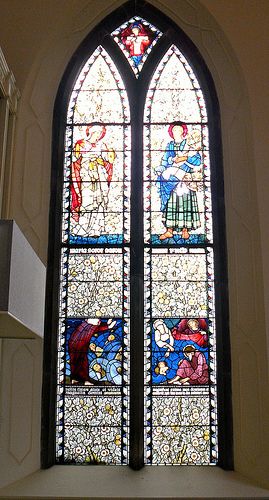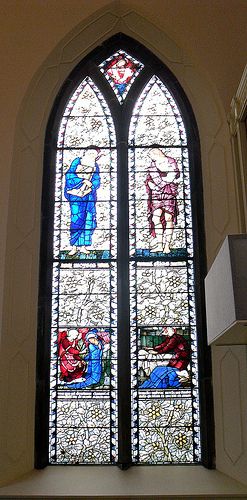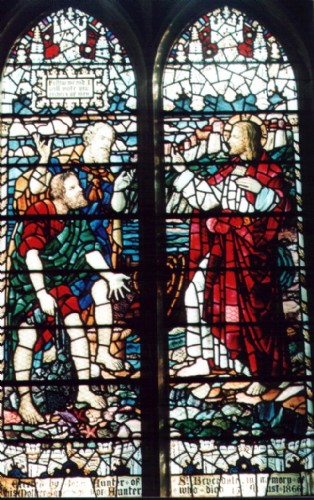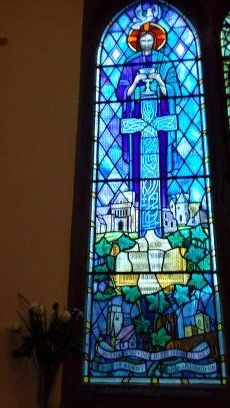The Beauty of Stained Glass
Burne-Jones, Gascoigne of Nottingham, John Clark, Crear MacCartney
A notable feature of the church, the stained glass windows of the Old Kirk are truly magnificent and one of the main attractions to visitors, as they flood the sanctuary with light and colour on all sides. They exhibit a wealth of different styles from Sir Edward Burne-Jones, the famous Victorian artist, to modern day John Clark and Crear McCartney, and include an unusual and distinctive series of portrait medallions of Reformed Scottish clergymen round the top of the side windows. Among these portraits are John Knox, the martyrs Patrick Hamilton and George Wishart, Alexander Henderson and George Gillespie, Thomas Chalmers, some Victorian churchmen, and Rev. John Martin of the Old Kirk.
Treasures of the Old Kirk include George Gillespie’s stained glass portrait from the original painted circa 1643 in the window beside the south porch while the memorial stone erected by his grandson after the original was destroyed by Archbishop Sharp is on the wall of the south porch.
Until recently, the church had two attractive stained-glass windows which dated back to 1839. Originally fitted in the east gable, they were replaced in 1886 by the Russell memorial windows and re-inserted in the west gable. Unfortunately, the glass and leadwork of those windows were seriously damaged by the disastrous fire in 1986, and they were replaced by the modem windows which now adorn the west gable but they can still be seen represented in their original “lino-print” form beside a model of the Old Kirk tower presently in the church.
The Burne-Jones Windows : The oldest windows are now the two stained-glass windows placed in the east wall of the church as a memorial to the late Mr James Russell who died suddenly in November 1877. A writer and agent of the City of Glasgow Bank in the High Street, he was a member of the Parish Church, but he was a most liberally-minded Christian as is evidenced by the fact that four ministers took part in his funeral service.
The windows were designed by Sir Edward Burne-Jones, a famous stained-glass artist, and were executed at the works of William Morris, Merton Abbey, Surrey. The association of Sir Edward Burne-Jones with William Morris, D.G. Rossetti, Madox Brown and other pre-Raphaelites, produced the distinctive artistic emphasis evident in the decoration of these windows. Michael Donnelly, an expert in this field, described them on a recent visit as perhaps the finest Burne-Jones windows in situ. The tinted glasses give a well-balanced scheme of colour and are valuable illustrations of the application of decorative art to window glass. The windows were dedicated by the Rev Professor Milligan, DD, of Aberdeen on 19 September 1886.

The south window is considered to be the finer of the two and depicts the Biblical character Ruth, with sheaves: the immigrant who showed what a full love is like. Below is a scene at Bethlehem with Joseph, Mary, the infant Jesus and the angel. The Biblical quotation underneath is: My soul doth magnify the Lord and my spirit hath rejoiced in God my Saviour. (Luke, chapter 1 : 46) Beside Ruth stands Miriam, sister of Moses, celebrating the defeat of the Egyptians with song and dance. (Exodus, chapter 15 : 20),with, below, Moses - and the Egyptians engulfed in the Red Sea. (Exodus, chapter 14 : 27) The Biblical quotation here is - Fear ye not; stand still and see the salvation of the Lord. (Exodus, chapter 14 : 13) On the other side of the organ pipes stand two famous Old Testament figures: Elijah, religious prophet and political leader, and Moses with the tablets of stone on which are written the Ten Commandments. Underneath Elias (Elijah) is a vignette of Elijah restoring to life the widow's son at Zarepthah. The story is found in 1 Kings, chapter 17 : 17-24. The familiar quotation below is from Psalm 23, the Shepherd's Psalm : In the valley of the shadow of death I will fear no evil for Thou art with me. (Psalm 23) |

Moses also has a story depicted below him : the Annunciation, as the angel Gabriel announces to Mary that she will bear a child, Jesus. (Luke, chapter 1 : 26-38) Underneath, the Biblical quotation is : I cried unto the Lord with my voice and He heard me out of His holy hill. (Psalm 3, verse 4.) |
All the windows in the north and south walls of the church were donated in 1914 by Mr John Hunter, a local businessman, whose name is remembered in nearby Hunter Street, the Hunter Halls of the church, and Hunter House, formerly the Hunter Hospital, in whose grounds he is buried. (at one time known as St.Brycedale House). Initially he had installed two windows in memory of his father and mother. The one on the north side at the east end is to his father William Hunter who died in 1862, and who had been an elder for 20 years, and the one on the south side opposite is to his mother Janet Smith or Hunter who died in 1866. He then wrote to the Heritors in June 1914 to say that he would put in, at his own expense, stained glass in the remaining windows of the church, one of which was in memory of his sister Janet who had died in 1903. These windows were dedicated on 7 February 1915 by the Rev Professor Cooper, DD, Glasgow University. The upper windows commemorate ministers in the Church of Scotland since the Reformation whose names are landmarks of the history of the Church, John Knox, the St. Andrews martyrs Patrick Hamilton and George Wishart, Edward Irving, George Gillespie, Thomas Chalmers, Archibald Charteris, and John Martin of the Old Kirk to name but a few, while the lower windows depict various aspects of the Holy Gospel. The work was carried out by the firm Gascoigne of Nottingham.
Dr Cooper in his remarks said the donor had beautified this parish church with perhaps the most complete and magnificent set of stained-glass windows to be seen anywhere in Scotland.
Viewing these windows from the north-east corner of the church, we see the Adoration of the Wise Men, with the star shining through the little stable window behind them. Next is the presentation of the child, Jesus, in the Temple, where he is welcomed by Simeon and Anna. (Luke, chapter 2)

Above the north porch door are two portraits of Old Testament figures: Ezekiel, the prophet-preacher, who taught the Jews that everyone is answerable to God for his life, and Daniel, the great example of Jewish faithfulness even when deported to a foreign environment.
Following around the walls, we meet Jesus in the Temple, (Luke, chapter 2 : 41-52), Jesus and the children, Jesus as the Good Shepherd, Jesus healing the sick, Jesus healing the centurion's servant, and Jesus calling the disciples at the seashore, with starfish and seashells in the details.
Above the south porch door are 2 further portraits of Old Testament prophets: Isaiah, a wise statesman who fearlessly denounced all injustice and wrong, and Jeremiah, who emphasised that religion is a personal thing and not a national cult. |
.JPG)
The oldest stained glass windows, in the west wall of the church, were unfortunately lost after the fire in 1986. However they were gloriously replaced by two new windows by John Clark , a Scottish stained-glass artist. Vibrant and striking, the lancets on the south side depict Moses and the Burning Bush, and Moses and the Pillar of Fire. Above is the motif of the Phoenix, symbolising the Old Testament as well as the resurrection and the creation of the new out of the ashes of the old. The Lancets on the north side depict the descending of the fire of the Holy Spirit on the apostles at Pentecost. Below the lancets are symbols of the historic bond between the Kirk and the Council - the Town House and the Old Kirk. Above is the dove, symbolising the Holy Spirit.
These windows commemorate the restoration of the building following the fire, which severely damaged the interior of the church in July 1986. The Rev John G Sim performed the dedication service for these windows on 11 September 1988.
The newest stained glass window by Crear McCartney, which completed those on the north side, was created in 1994 and gifted to the church by Rev. John G. Sim, a former Minister here, in memory of his late wife, Jean, a much-loved companion in his ministry. The window was dedicated at the service of celebration and thanksgiving for the 750th anniversary of the consecration of the Old Kirk.
This window shows Christ holding one of the Church's 17th century silver Communion cups above a Celtic cross entwined with a vine. The Celtic Cross in the centre symbolizes the Celtic beginnings of Christianity here in Fife, and is also a happy reminder of the Sims' association with the Iona Community. At the foot of the Cross are vignettes of Iona Abbey, and Inchcolm ("Island of Columba") Abbey, together with the Old Kirk and the Abbey of Dunfermline. This reminds us of the roots of the Old Kirk in both the Celtic and Roman Catholic traditions, for in 1244 Bishop de Bernham bestowed the Old Kirk upon Dunfermline Abbey as part of an effort to consolidate the Pope's authority on the Scottish Church. |

Christ's words to his disciples, "I am the vine; you are the branches" (John chapter 15 : 5) are encircled by a Naturalistic vine which binds together the vignettes of the 4 churches and continues in a stylised form to decorate the Celtic Cross. The twelve Apostles are symbolized on the vine – each three part bud marking the Apostle's special association with the Holy Trinity.
Captured in this symbolism is a joyful memory of the sharing in gifts and worship of fellow-Christians from St. Marie's Roman Catholic Church, St. Peter's Episcopal Church, the Free Churches and other Presbyterian churches at the wonderful rededication service of the Old Kirk in 1987, after restoration from the fire. This was a happy occasion shortly before Mr. Sim's retiral, with many strands of Christian tradition united in common worship in the town's mother church.
The Christ stands behind the empty cross. He welcomes the congregations as they enter the Kirk, reminding them that wherever two or three are gathered together in His name there will He be also. (Matthew, chapter 18 : 20) He presents us with His Cup of Redemption. The dove above His head serves as a double symbol. First, as a symbol of the Holy Spirit who is ever with Christ's Church throughout all ages and secondly because it is also the symbol of St. Columba and moves us to give thanks for the good Columba and his disciples from Iona, who first brought the Gospel to the Kingdom of Fife.
The background of the window is radiant with the blues of the Sound of Iona, which Jean Sim loved so much, and asked to be incorporated in the window.
In 2000 a stained-glass plaque to the design of one of the children of the Old Kirk was placed in one of the Church windows to commemorate 2000 years of Christianity, beneath one marking the Guild centenary. In this way the stained glass windows themselves tell an ongoing story of over 2000 years of Christian faith and worship, woven from Celtic roots through many traditions and still continuing today in this place.
|
